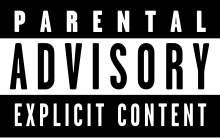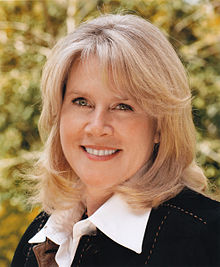Parental Advisory

Parental Advisory (abbreviated as PAL or PA) is a voluntary warning label placed on
Recordings with the Parental Advisory label are often released alongside a censored version that reduces or eliminates the objectionable material. Several retailers will distribute both versions of the product, occasionally with an increased price for the censored version, while some sellers offer the amended pressing as their main option and choose not to distribute the explicit counterpart. The label has been widely criticized as ineffective in limiting the inappropriate material to which young audiences are exposed.
Background

Shortly after their formation in April 1985, the
In 1990, the now standard black-and-white warning label design reading "Parental Advisory: Explicit Lyrics" was introduced and was to be placed on the bottom right-hand section of a given product. The first album to bear the "black and white" Parental Advisory label was the 1990 release of
Application

The "Parental Advisory Label Program" in the United States and the "Parental Advisory Scheme" in the United Kingdom lack agreed-upon standards for using the warning label, although they provide guidelines for its recommended inclusion.[7][8] Although a voluntary practice that is ultimately left to the discretion of record labels,[9] the RIAA suggests that material with "strong language or depictions of violence, sex, or substance abuse to such an extent as to merit parental notification" be affixed with the Parental Advisory label.[8] The BPI additionally requests that "racist, homophobic, misogynistic or other discriminatory language or behavior" be taken under consideration when determining the appropriateness of a record.[7]

Physical copies of albums which have the label generally have it as a permanent part of the artwork, being printed with the rest of the cover. In some cases, the label is affixed as a sticker to the front of the case, which can be removed by putting the artwork in a different case. Audio recordings that include Parental Advisory labels in their original formats are generally released in censored versions that reduce or completely eliminate the questionable material.
Impact
Since its introduction, the effectiveness of the Parental Advisory label has frequently been called into question. Jon Wiederhorn from

Danny Goldberg from Gold Village Entertainment opined that the Parental Advisory label offered minimal value other than "being a way for certain retailers like Wal-Mart to brand themselves as 'family friendly'"; he felt that children were successful in getting content they desired "even before the Internet", and believed that the label had little impact on sales figures.[2] In contrast, the RIAA maintains that "it's not a PAL Notice that kids look for, it's the music". They stated that research they had gathered revealed that "kids put limited weight on lyrics in deciding which music they like, caring more about rhythm and melody" and implied that the label is not a deciding factor for a given purchase.[8] Tom Cole from NPR commented that the Parental Advisory label has become "a fact of music-buying life", which made it difficult for current consumers to understand the widespread controversy that came about from its introduction.[2] Greg Beato of Reason observed that by the 1990s, "A hip-hop album that didn't warrant a Tipper sticker was artistically suspect."[16]
The label has become well known enough to be parodied.
Edited counterparts
It is fairly common for an album which received the Parental Advisory seal to be sold alongside an "edited" version which removes objectionable content, usually to the same level as a radio edit. The RIAA Guidelines however state "an Edited Version need not remove all potentially objectionable content from the sound recording."[18] These albums are packaged nearly-identically to their explicit counterparts, usually with the only indicator being the lack of Parental Advisory seal, although if the artwork is deemed 'explicit' too, it will normally be censored. In the case of some albums, a black box reading "EDITED VERSION" is placed where the Parental Advisory seal would be. This was part of new guidelines introduced on April 1, 2002, which also included a label that featured "Edited Version Also Available" next to the Parental Advisory seal.[19]
See also
- Parents Music Resource Center
- Recording Industry Association of America
- MPAA film rating system(movie audience suitability: G/PG/PG-13/R/NC-17)
- Content rating
References
- ^ a b Deflem, Mathieu. 2020. "Popular Culture and Social Control: The Moral Panic on Music Labeling." American Journal of Criminal Justice, 45(1):2-24 (First published online July 24, 2019).
- ^ a b c d Cole, Tom (October 29, 2010). "You Ask, We Answer: 'Parental Advisory' Labels — The Criteria And The History". NPR. Retrieved July 4, 2014.
- ^ Schonfeld, Zach (November 10, 2015). "Does the Parental Advisory Label Still Matter?". Newsweek. IBT Media. Retrieved December 17, 2017.
- ^ Browne, David (May 22, 1992). "As Prudish as They Wanna Be". Entertainment Weekly. Time Inc. Retrieved July 5, 2014.
- ^ Viacom. Retrieved July 4, 2014.
- ^ Sweney, Mark (June 2, 2011). "Parental warnings to be introduced for online music". The Guardian. Retrieved July 4, 2014.
- ^ a b c "BPI Parental Advisory Scheme Guidelines" (PDF). British Phonographic Industry. September 2011. Retrieved October 17, 2019.
- ^ a b c d "Parental Advisory Label ("PAL") Program". Recording Industry Association of America. Archived from the original on July 1, 2014. Retrieved July 5, 2014.
- IAC. Retrieved July 5, 2014.
- ^ "Music Content Policy". Walmart. Retrieved July 5, 2014.
- ^ "Drake Take Care at Target". Target Corporation. Retrieved July 5, 2014.
- ^ Mumbi Moody, Nekesa. "Green Day: No-go to Wal-Mart policy on edited CDs". ABC News. American Broadcasting Company. Retrieved July 5, 2014.
- ^ "iTunes: About iTunes Store Parental Advisories". Apple Inc. Retrieved July 5, 2014.
- ^ "What Does 'Explicit Content' Mean on Music Streaming Platforms". soundplate.com.
- ^ Thomas, Andy (March 10, 2010). "Is Parental Advisory sticker still being affixed to albums these days? If so, how effective is it? Actually, was it ever effective?". Westword. Voice Media Group. Retrieved July 5, 2014.
- ^ Beato, Greg (July 28, 2009). "As Nasty As They Wanna Be". Reason. Retrieved June 7, 2018.
- ^ "New Sets offer Double Dose of Guns 'n' Roses". Sun Sentinel. September 11, 1991. Retrieved April 19, 2019.
- ^ "Parental Advisory Label ("PAL") Program". Recording Industry Association of America. Archived from the original on August 10, 2015. Retrieved August 1, 2015.
- ^ "Rating & labeling entertainment | Freedom Forum Institute". www.freedomforuminstitute.org. Retrieved August 2, 2018.
